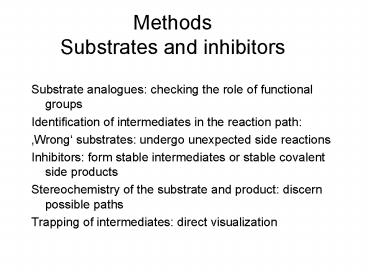Substrate analogues: checking the role of functional groups PowerPoint PPT Presentation
Title: Substrate analogues: checking the role of functional groups
1
- Substrate analogues checking the role of
functional groups - Identification of intermediates in the reaction
path - Wrong substrates undergo unexpected side
reactions - Inhibitors form stable intermediates or stable
covalent side products - Stereochemistry of the substrate and product
discern possible paths - Trapping of intermediates direct visualization
2
- Substrate analogues
H
3
- Substrate analogues
Loss of the S (thioester) does not affect binding
(and radical formation and catalysis), but loss
of the carbonyl group does.
4
- Substrate analogues
Loss of the S (thioester) does not affect binding
(and radical formation and catalysis), but loss
of the carbonyl group does. The carbonyl group
binds tightly and provides the energy.
5
- Wrong substrates bromopyruvate with
transaminase
Inhibition by covalent modification
1.
2.
non-enzymatic
6
- Wrong substrates bromopyruvate with
transaminase
wrong reaction that explains the product
pyruvate
make quinone
stabilize tetrahedral intermediate
unexpected reaction
7
- Inhibitors Kinetic analysis shows, that another
observed pathway (to the covalently inhibited
enzyme) must have the same intermediate
The base can react with the common intermediate,
an enamine.
8
- Stereochemistry of the substrate and product
9
- Stereochemistry of the substrate and product
10
- Stereochemistry of the substrate and product
L-haloacid dehalogenase direct attack by H2O or
via a covalent intermediate?
11
- Trapping of intermediates
L-haloacid dehalogenase has a pH optimum of 9.5.
At pH 5 the reaction is trapped at an
intermediate. This stable intermediate can be
characterized in a crystal structure.
12
- Trapping of intermediates
13
- Trapping of intermediates
- Why is the intermediate trapped at pH 5?
- In the structure at pH 5, no water molecule is
close to Asp 8 and available for hydrolysis. - At pH 9.5 (the pH optimum) a structural change
must occur and a water molecule enters the active
site. Moreover, at higher pH, water is more
likely to deprotonate and then more nucleophilic.
PowerShow.com is a leading presentation sharing website. It has millions of presentations already uploaded and available with 1,000s more being uploaded by its users every day. Whatever your area of interest, here you’ll be able to find and view presentations you’ll love and possibly download. And, best of all, it is completely free and easy to use.
You might even have a presentation you’d like to share with others. If so, just upload it to PowerShow.com. We’ll convert it to an HTML5 slideshow that includes all the media types you’ve already added: audio, video, music, pictures, animations and transition effects. Then you can share it with your target audience as well as PowerShow.com’s millions of monthly visitors. And, again, it’s all free.
About the Developers
PowerShow.com is brought to you by CrystalGraphics, the award-winning developer and market-leading publisher of rich-media enhancement products for presentations. Our product offerings include millions of PowerPoint templates, diagrams, animated 3D characters and more.

